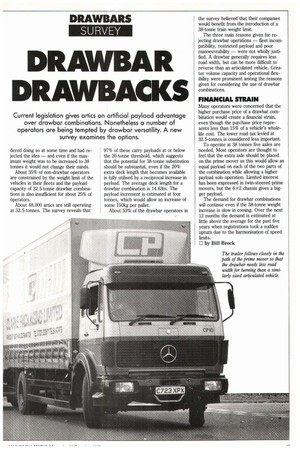DRAWBAR DRAWBACKS
Page 47

If you've noticed an error in this article please click here to report it so we can fix it.
Current legislation gives artics an artificial payload advantage over drawbar combinations. Nonetheless a number of operators are being tempted by drawbar versatility. A new survey examines the options.
dered doing so at some time and had rejected the idea — and even if the maximum weight was to be increased to 38 tonnes it would not change their minds.
About 35% of non-drawbar operators are constrained by the weight limit of the vehicles in their fleets and the payload capacity of 32.5-tonne drawbar combinations is also insufficient for about 25% of operators.
About 48,000 artks are still operating at 32.5-tonnes. The survey reveals that 97% of these carry payloads at or below the 20-tonne threshold, which suggests that the potential for 38-tonne substitution should be substantial, even if the 20% extra deck length that becomes available is fully utilised by a reciprocal increase in payload. The average deck length for a drawbar combination is 14.6.3m. The payload increment is estimated at four tonnes, which would allow an increase of some 150kg per pallet.
About 53% of the drawbar operators in the survey believed that their companies would benefit from the introduction of a 38-tonne train weight limit.
The three main reasons given for rejecting drawbar operations — fleet incompatibility, restricted payload and poor manoeuvrability — were not wholly justified. A drawbar generally requires less road width, but can be more difficult to reverse than an articulated vehicle. Greater volume capacity and operational flexibility were prominent among the reasons given for considering the use of drawbar combinations.
FINANCIAL STRAIN
Many operators were concerned that the higher purchase price of a drawbar combination would create a financial strain, even though the purchase price represents less than 15% of a vehicle's wholelife cost. The lower road tax levied at 32.5-tonnes is considered less important.
To operate at 38 tonnes five axles are needed. Most operators are thought to feel that the extra axle should be placed on the prime mover as this would allow an equal payload on each of the two parts of the combination while allowing a higher payload solo operation. Limited interest has been expressed in twin-steered prime movers, but the 6x2 chassis gives a bigger payload.
The demand for drawbar combinations will continue even if the 38-tonne weight increase is slow in coming. Over the next 12 months the demand is estimated at little above the average for the past five years when registrations took a sudden upturn due to the harmonisation of speed limits.
by Bill Brock








































































































